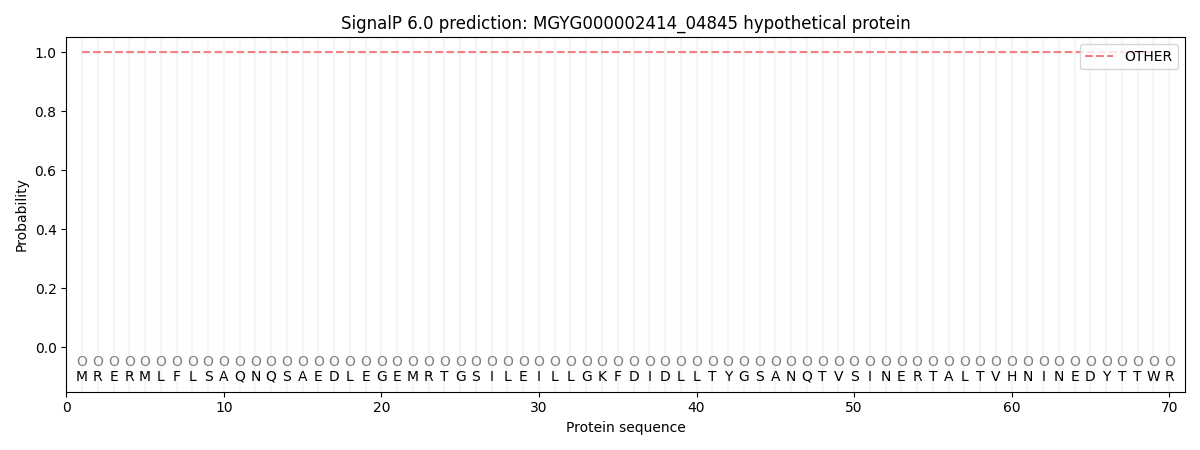You are browsing environment: HUMAN GUT
CAZyme Information: MGYG000002414_04845
You are here: Home > Sequence: MGYG000002414_04845
Basic Information |
Genomic context |
Full Sequence |
Enzyme annotations |
CAZy signature domains |
CDD domains |
CAZyme hits |
PDB hits |
Swiss-Prot hits |
SignalP and Lipop annotations |
TMHMM annotations
Basic Information help
| Species | Paenibacillus odorifer | |||||||||||
|---|---|---|---|---|---|---|---|---|---|---|---|---|
| Lineage | Bacteria; Firmicutes; Bacilli; Paenibacillales; Paenibacillaceae; Paenibacillus; Paenibacillus odorifer | |||||||||||
| CAZyme ID | MGYG000002414_04845 | |||||||||||
| CAZy Family | GT4 | |||||||||||
| CAZyme Description | hypothetical protein | |||||||||||
| CAZyme Property |
|
|||||||||||
| Genome Property |
|
|||||||||||
| Gene Location | Start: 5420484; End: 5421671 Strand: - | |||||||||||
CDD Domains download full data without filtering help
| Cdd ID | Domain | E-Value | qStart | qEnd | sStart | sEnd | Domain Description |
|---|---|---|---|---|---|---|---|
| cd03801 | GT4_PimA-like | 3.41e-09 | 168 | 394 | 132 | 364 | phosphatidyl-myo-inositol mannosyltransferase. This family is most closely related to the GT4 family of glycosyltransferases and named after PimA in Propionibacterium freudenreichii, which is involved in the biosynthesis of phosphatidyl-myo-inositol mannosides (PIM) which are early precursors in the biosynthesis of lipomannans (LM) and lipoarabinomannans (LAM), and catalyzes the addition of a mannosyl residue from GDP-D-mannose (GDP-Man) to the position 2 of the carrier lipid phosphatidyl-myo-inositol (PI) to generate a phosphatidyl-myo-inositol bearing an alpha-1,2-linked mannose residue (PIM1). Glycosyltransferases catalyze the transfer of sugar moieties from activated donor molecules to specific acceptor molecules, forming glycosidic bonds. The acceptor molecule can be a lipid, a protein, a heterocyclic compound, or another carbohydrate residue. This group of glycosyltransferases is most closely related to the previously defined glycosyltransferase family 1 (GT1). The members of this family may transfer UDP, ADP, GDP, or CMP linked sugars. The diverse enzymatic activities among members of this family reflect a wide range of biological functions. The protein structure available for this family has the GTB topology, one of the two protein topologies observed for nucleotide-sugar-dependent glycosyltransferases. GTB proteins have distinct N- and C- terminal domains each containing a typical Rossmann fold. The two domains have high structural homology despite minimal sequence homology. The large cleft that separates the two domains includes the catalytic center and permits a high degree of flexibility. The members of this family are found mainly in certain bacteria and archaea. |
| COG0438 | RfaB | 2.46e-07 | 158 | 394 | 132 | 373 | Glycosyltransferase involved in cell wall bisynthesis [Cell wall/membrane/envelope biogenesis]. |
| pfam13692 | Glyco_trans_1_4 | 7.01e-07 | 245 | 363 | 19 | 138 | Glycosyl transferases group 1. |
| cd03792 | GT4_trehalose_phosphorylase | 0.002 | 248 | 382 | 217 | 362 | trehalose phosphorylase and similar proteins. Trehalose phosphorylase (TP) reversibly catalyzes trehalose synthesis and degradation from alpha-glucose-1-phosphate (alpha-Glc-1-P) and glucose. The catalyzing activity includes the phosphorolysis of trehalose, which produce alpha-Glc-1-P and glucose, and the subsequent synthesis of trehalose. This family is most closely related to the GT4 family of glycosyltransferases. |
| cd03811 | GT4_GT28_WabH-like | 0.003 | 153 | 386 | 115 | 342 | family 4 and family 28 glycosyltransferases similar to Klebsiella WabH. This family is most closely related to the GT1 family of glycosyltransferases. WabH in Klebsiella pneumoniae has been shown to transfer a GlcNAc residue from UDP-GlcNAc onto the acceptor GalUA residue in the cellular outer core. |
CAZyme Hits help
| Hit ID | E-Value | Query Start | Query End | Hit Start | Hit End |
|---|---|---|---|---|---|
| AWV35454.1 | 5.11e-285 | 1 | 395 | 1 | 395 |
| AIQ76163.1 | 1.20e-283 | 1 | 395 | 1 | 395 |
| AIQ25689.1 | 4.99e-216 | 1 | 395 | 1 | 394 |
| AIQ37472.1 | 1.93e-213 | 1 | 395 | 1 | 394 |
| ASA23773.1 | 4.86e-134 | 1 | 395 | 1 | 391 |
Swiss-Prot Hits help
SignalP and Lipop Annotations help
This protein is predicted as OTHER

| Other | SP_Sec_SPI | LIPO_Sec_SPII | TAT_Tat_SPI | TATLIP_Sec_SPII | PILIN_Sec_SPIII |
|---|---|---|---|---|---|
| 1.000047 | 0.000018 | 0.000000 | 0.000000 | 0.000000 | 0.000000 |
